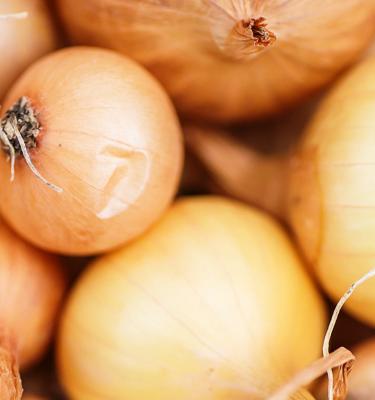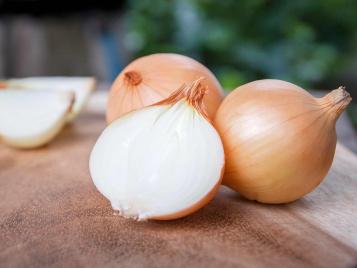

How to grow onions
The basis of so many delicious dishes, onions (Allium cepa) are an essential ingredient in every cook’s store cupboard. With so many tasty types of onions available, why not grow your own and try some of them out? Follow our simple guide to growing onions.
What are the best onion varieties to plant?
With so many types of onions available, it can be difficult to choose which one to grow! Here are a few of our favourites:
- Onion ‘Stuttgarter Giant’: produces firm, tasty, slightly flattened bulbs, good for storing.
- Onion ‘Red Baron’: a late maturing variety with dark red bulbs, stores well.
- Onion ‘Jetset’: an early maturing variety with yellow-brown bulbs, stores well.
- Onion ‘Sturon’: a reliable variety with good bolt resistance, producing flavourful round bulbs that store well.
- Onion ‘Troy’: suitable for autumn planting, with good bolt resistance, producing tasty yellow-skinned bulbs.

Onion growing equipment list
To grow onions at home, you will need:
- Onion sets (like bulbs, but harvested earlier)
- Spade
- Fork
- Supply of compost or well-rotted farmyard manure such as Miracle-Gro Premium All Purpose Compost
- Fertiliser
- Netting
When to plant onions
Some onion varieties can be planted in autumn for an early summer harvest, but the bulbs may rot in heavy, wet soils. The best time to plant onion sets is in early to mid-spring.
Onions need a rich, fertile neutral or alkaline soil in full sun. To prepare the soil for spring planting, dig in lots of compost or well-rotted farmyard manure in autumn and leave it to settle over winter.
How to plant onions
Although you can grow onions from seed, it’s simpler to grow them from sets. Sets are young onion bulbs, grown especially for planting.
- Before planting in spring, dig over the plot, clearing it of all weeds and stones. Tread down the soil and rake it to produce a level surface with a light, crumbly texture.
- A couple of weeks before planting, rake in 35g/m2 of granulated fertiliser or 75g/m2 of dried chicken manure pellets. If you weren’t able to dig in compost or manure in autumn, then double the amount of fertiliser used.
- Plant onion sets 20cm (8in) apart, with the tips just showing above the soil. Allow 30cm between rows.
- Water in after planting – this helps to settle the soil around the bulbs.
- Cover the area with netting to stop birds pulling up the young plants.
Caring for onions
Follow these tips for a good onion harvest:
- Keep the plot well weeded. Hoeing between rows risks damaging foliage and bulb tips, so weed by hand where possible.
- Water regularly in dry periods.
- Remove any flowerspikes as soon as they appear.
- Stop watering once the leaves start yellowing – this means that the bulbs are starting to swell.
Harvesting onions
Spring-planted onions should be ready to harvest in late summer and early autumn. Autumn-planted onions will be ready to harvest from early to mid-summer. Once the foliage starts to yellow and topple over, the bulbs are ready to be harvested. Use a fork to lift them carefully, taking care not to bruise the bulbs.
Storing onions
- Place the bulbs in a single layer on a drying rack or on a slatted shelf that allows air to circulate around the bulbs.
- Leave them outside in the sun or in a greenhouse for a couple of weeks to dry.
- Once the skins are dry and papery, store the bulbs in net bags or plait the foliage to form bundles.
- Store somewhere light, cool and well-ventilated. Bulbs stored in the dark are more likely to sprout.
Common pests and diseases of onions
Onions bolting
Bolting occurs when onions stop developing their bulbs and instead produce flowers. It can be triggered by stress, such as sudden dry periods or cold snaps. Onions that have bolted can’t be stored but are still edible.
- Choose varieties that have been heat-treated to reduce the risk of bolting, or look for bolt-resistant varieties.
- Cover plants with fleece to protect them against sudden cold snaps in spring.
- Water plants regularly in hot, dry periods.
Onion fly
Onion flies lay eggs in the soil around the base of onion plants and once the larvae hatch, they burrow into the bulb and eat it. Leaves yellow and wilt, and small maggots can be seen in the bulbs.
- Grow onions under insect-proof netting.
- Onions grown from sets are less at risk from onion fly.
Allium leaf miner
Adult leaf miners feed on the sap of onion leaves, and larvae feed on the bulbs themselves. Lines of small white dots appear on leaves and maggots can be seen in the bulbs.
- Grow crops under insect-proof netting.
- Avoid planting onions in soil where allium leaf miner has been a problem.
Onion white rot
Onion white rot is a soil-born fungus that causes leaves to yellow and wilt, and bulbs to rot.
- No chemical controls are available.
- Avoid planting onions in soil where this has previously been a problem.
Leek rust
Leek rust is a fungal disease which can affect all alliums. It appears as orange spots on leaves, and is more likely in wet conditions. Heavy infections can affect yield.
- Space plants well to ensure good air circulation.
- Remove and destroy any affected leaves.
- Don’t plant onions in soil where this has previously been a problem.
Key features of onions
| Flowering season(s) | Spring, Summer |
|---|---|
| Foliage season(s) | Spring, Summer, Autumn, Winter |
| Sunlight | Full shade, Partial shade, Full sun |
| Soil type | Clay, Loamy, Sandy |
| Soil pH | Neutral |
| Soil moisture | Moist but well-drained |
| Ultimate height | Up to 30cm (1ft) |
| Ultimate spread | Up to 10cm (4in) |
| Time to ultimate height | 5 months |



